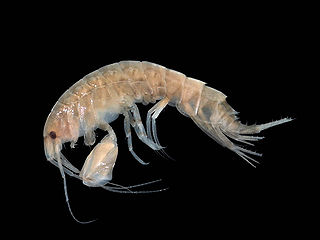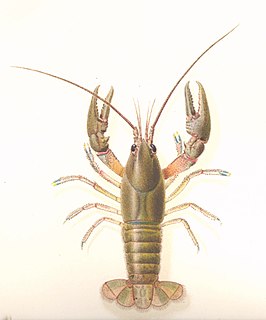
Crayfish are freshwater crustaceans resembling small lobsters. In some parts of the United States, they are also known as crawfish, craydids, crawdaddies, crawdads, freshwater lobsters, mountain lobsters, mudbugs, or yabbies. Taxonomically, they are members of the superfamilies Astacoidea and Parastacoidea. They breathe through feather-like gills. Some species are found in brooks and streams, where fresh water is running, while others thrive in swamps, ditches, and paddy fields. Most crayfish cannot tolerate polluted water, although some species, such as Procambarus clarkii, are hardier. Crayfish feed on animals and plants, either living or decomposing, and detritus.

Cambarus is a large and diverse genus of crayfish from the United States and Canada. The adults range in size from about 5 centimeters (2 in) up to approximately 15 centimeters (6 in).

Squat lobsters are dorsoventrally flattened crustaceans with long tails held curled beneath the cephalothorax. They are found in the two superfamilies Galatheoidea and Chirostyloidea, which form part of the decapod infraorder Anomura, alongside groups including the hermit crabs and mole crabs. They are distributed worldwide in the oceans, and occur from near the surface to deep sea hydrothermal vents, with one species occupying caves above sea level. More than 900 species have been described, in around 60 genera. Some species form dense aggregations, either on the sea floor or in the water column, and a small number are commercially fished.

Cherax is the most widespread genus of fully aquatic crayfish in the Southern Hemisphere. Together with Euastacus, it is also the largest crayfish genus in the Southern Hemisphere. Its members may be found in lakes, rivers, and streams across most of Australia and New Guinea. In Australia, the many species of Cherax are commonly known as yabbies. The most common and widely distributed species in Australia is the common yabby. It is generally found in lowland rivers and streams, lakes, swamps, and impoundments at low to medium altitude, largely within the Murray–Darling Basin. Common yabbies are found in many ephemeral waterways, and can survive dry conditions for long periods of time by aestivating in burrows sunk deep into muddy creek and swamp beds. In New Guinea, Cherax crayfish are found widely in rivers, streams, and lakes, with a particularly high diversity in the Paniai Lakes. New Guinea is also home to the only known cave-living crayfish in the Southern Hemisphere, C. acherontis. Some species are very colourful and sometimes seen in the freshwater aquarium trade.

The acocil is a species of crayfish in the family Cambaridae. It is endemic to Mexico, where it is known from Jalisco and Puebla.

Cambarellus is a genus of small freshwater crayfish in the family Cambaridae. The 19 species are found in Mexico and the Gulf States of the United States. Among the Mexican species, C. areolatus, C. patzcuarensis, and C. prolixus are considered seriously threatened by the IUCN, and C. alvarezi is already extinct. C. chihuahuae was also believed to be extinct until rediscovered in 2012. C. alvarezi and four undescribed, extinct Cambarellus species were restricted to desert spring systems in southwestern Nuevo León; each one shared its habitat with a Cyprinodon pupfish.
Cambarus batchi, the bluegrass crayfish, is a species of crayfish in the family Cambaridae. It is found in North America.
Cambarus hiwasseensis, the Hiwassee crayfish, is a species of crayfish in the family Cambaridae. It is found in North America.

Cambarus scotti, the Chatooga crayfish, is a species of crayfish in the family Cambaridae. It is found in North America.

The marbled crayfish or Marmorkrebs, is a parthenogenetic crayfish that was discovered in the pet trade in Germany in the 1990s. Marbled crayfish are closely related to the "slough crayfish", Procambarus fallax, which is widely distributed across Florida. No natural populations of marbled crayfish are known. Information provided by one of the original pet traders as to where the marbled crayfish originated was deemed "totally confusing and unreliable". The informal name Marmorkrebs is German for "marbled crayfish".

Cambarellus patzcuarensis is a small, threatened species of crayfish in the family Cambaridae. It is native to Mexico and often kept in aquariums.

The Big Sandy crayfish, Cambarus callainus, are freshwater, tertiary burrowing crustaceans of the family Cambaridae. They are found in the streams and rivers of Appalachia in Virginia, West Virginia, and Kentucky, in what is known as the Big Sandy watershed. Populations are often mistaken with Cambarus veteranus, but morphological and genetic data suggests that these are separate taxa; however, both are protected under the Endangered Species Act. There is very little information available on the Big Sandy crayfish because it is a relatively new species.

Crustaceans form a large, diverse arthropod taxon which includes such animals as crabs, lobsters, crayfish, shrimps, prawns, krill, woodlice, and barnacles. The crustacean group can be treated as a subphylum under the clade Mandibulata; because of recent molecular studies it is now well accepted that the crustacean group is paraphyletic, and comprises all animals in the clade Pancrustacea other than hexapods. Some crustaceans are more closely related to insects and the other hexapods than they are to certain other crustaceans.

Cherax snowden is a species of crayfish from West Papua in Indonesia. In the wild, they live in freshwater river tributaries. It is popular as a freshwater aquarium pet across Asia, Europe, and North America because of its orange-tipped claws. Specimens were previously misidentified as members of Cherax holthuisi, also from West Papua.

Raymunida insulata is a species of squat lobster in the family Munididae from the Pacific and Indian oceans. The species can be distinguished by its morphology and its mitochondrial cytochrome c oxidase subunit I sequences.
Raymunida erythrina is a species of squat lobster in the family Munididae from the Pacific and Indian oceans. The species can be distinguished by its morphological characters and its mitochondrial cytochrome c oxidase subunit I sequences.
Raymunida dextralis is a species of squat lobster in the family Munididae from the Pacific and Indian oceans. The species can be distinguished by its morphological characters and its mitochondrial cytochrome c oxidase subunit I sequences.

Raymunida confundens is a species of squat lobster in the family Munididae from the Pacific and Indian oceans. The species can be distinguished by its morphological characters and its mitochondrial cytochrome c oxidase subunit I sequences.

Cambarus robustus, known generally as the robust crayfish or big water crayfish, is a species of crayfish in the family Cambaridae. It is found in North America.

The Zacapu Lagoon is a small perennial wetland located within the urban area of Zacapu, Mexico. It has an approximate area of 33 hectares, connects with the Lerma River through the Angulo River and is fed by 20 springs. The Zacapu Lagoon was included within the Ramsar wetlands in June 2004.
















